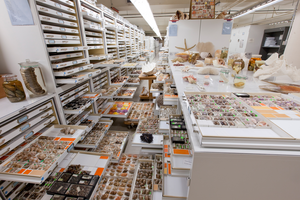A group of natural history museums has mapped the total collections from 73 of the world’s largest natural history museums in 28 countries, with the aim of creating a global collection of all the world’s museums to address urgent issues like climate change, food insecurity, human health, pandemic preparedness, and wildlife conservation. The lead scientists from a dozen large natural history museums created an innovative framework to rapidly evaluate the size and composition of natural history museum collections globally. The survey confirmed an aggregate collection of more than 1.1 billion objects, managed by more than 4,500 science staff and nearly 4,000 volunteers. Natural history collections are uniquely positioned to inform responses to today’s interlocking crises. By creating this framework and survey, project organizers aim to create a foundation for the global museum network to work together to support future global sustainability, biodiversity, and climate frameworks using knowledge gained from museum collections.
A group of natural history museums from 28 countries have collaborated to map the total collections of 73 of the largest natural history museums globally, as part of a major effort to inventory global holdings. This groundbreaking initiative was organized by the Smithsonian National Museum of Natural History in Washington DC, the American Museum of Natural History Museum in New York City, and the Natural History Museum in London.
Natural history museums hold an unprecedented archive of the history of our planet and solar system, beyond their public galleries. These collections provide unique insight into the planet’s past, which are increasingly being used to make actionable forecasts to chart our future. The initiative aims to evaluate the size and composition of natural history museum collections globally and address 21st-century challenges such as climate change, food insecurity, human health, pandemic preparedness, and wildlife conservation.
The lead scientists from a dozen large natural history museums created an innovative and straightforward framework to understand this immense, untapped resource better. The results of this framework were published in Science magazine in a paper titled, “A Global Approach for Natural History Museum Collections.” The paper can be found online at the Science press package.
The initiative is a departure from the traditional independent operations of museums and instead imagines a global collection composed of all the world’s museums. This collaborative approach by natural history museums represents a groundbreaking effort that will help scientists and decision-makers find solutions to address global challenges in the 21st century.
In conclusion, the initiative by the natural history museums to inventory global holdings represents a significant milestone. With this groundbreaking approach, natural history museums have made it possible to utilize their unique collections to tackle global challenges such as climate change, food insecurity, human health, pandemic preparedness, and wildlife conservation. The world can now utilize the wealth of information held by natural history museums to predict future events and find actionable solutions to tackle them.
A survey of collection holdings across museums was conducted by the Smithsonian National Museum of Natural History, American Museum of Natural History Museum in New York City, and the Natural History Museum in London, collaborating with over 150 museum directors and scientists representing 73 natural history museums and herbaria. The survey created a common vocabulary of 19 collection types spanning biological, geological, paleontological, and anthropological collections, as well as 16 terrestrial and marine regions that cover the entirety of the Earth. The survey organizers wanted to quickly estimate the size and composition of the global collection to build a collective strategy for the future.
The survey revealed an aggregate collection of over 1.1 billion objects managed by over 4,500 science staff and nearly 4,000 volunteers. Although the aggregate collection is vast, the survey showed conspicuous gaps across museum collections in areas including tropic and polar regions, marine systems, and undiscovered arthropod and microbial diversity. These gaps could provide a roadmap for coordinated collecting efforts going forward.
Lead author Kirk Johnson, Sant Director of the Smithsonian National Museum of Natural History, said the report is a significant summary, but it is only the first step in surveying the global collection and tapping its enormous potential. Natural history collections are uniquely positioned to inform responses to today’s interlocking crises, but due to lack of funding and coordination, the information embedded in museum collections remains largely inaccessible. With strategic coordination, a global collection has the potential to guide decisions that will shape the future of humanity and biodiversity.
The project organizers aim to create a foundation for the global museum network to work together to support future global sustainability, biodiversity, and climate frameworks using knowledge gained from museum collections. This will enable all museums to be more strategic as they plan their collection efforts in the future.
The historic concentration of large museums in North America and Europe can be a barrier to knowledge-sharing and perpetuates power imbalances rooted in the colonial history of museum science, and the authors recognize this issue. In the future, it is crucial that the global collection also reflect and support museums elsewhere in the world.
Natural history collections are the evidence from which scientists derive knowledge, including knowledge that can be applied to critical issues facing our planet today. Michael Novacek, curator in the Division of Paleontology and former provost of science at the American Museum of Natural History, said, “This has never been more urgent than today, as global biodiversity loss and climate change are accelerating.” Natural history museums are well-positioned to help address these challenges with their vast collections of historical evidence, and by working together, they can guide the decisions that will shape the future of our planet.
Doug Gurr, Director of the Natural History Museum in London, highlights the importance of natural science collections in addressing the planetary crisis. He emphasizes the need for equitable international collaboration and capacity-building with partners from all countries, utilizing technological advances to further scientific understanding and make data available for all. The paper explores the applications of collection-based research, providing case studies that demonstrate the value of museum natural history collections in studying various topics, including pandemic preparedness, global change, biodiversity, invasive species, colonial heritage, and museomics.
The authors stress the importance of developing global and local partnerships that showcase the relevance of natural history collections for specific scientific, societal, and conservation challenges. They argue that the benefits of natural history collections apply to everyone on the planet.
The full Global Collections dashboard is available at https://rebrand.ly/global-collections. The paper also provides images that address some of the issues raised and a list of participating institutions and authors.
The National Museum of Natural History in Washington DC, the American Museum of Natural History in New York City, and the Natural History Museum in London are among the most significant natural history museums in the world. These museums are dedicated to maintaining and preserving the world’s most extensive collection of natural history specimens and human artifacts. The American Museum of Natural History encompasses more than 40 permanent exhibition halls and galleries for temporary exhibitions, and the Museum’s scientists draw on a permanent collection of more than 34 million specimens and artifacts. The Natural History Museum in London also promotes scientific and cultural education and aims to engage the public with the natural world.
In conclusion, natural history collections represent a crucial resource for scientific understanding and prediction of global change. The authors of the paper emphasize the need for coordinated and strategic efforts to ensure the long-term security and value of natural history collections.
The Natural History Museum in the UK is a top science research center and the most-visited indoor attraction in the country. Its vision is to create a future where people and the planet thrive, and it advocates for balancing humanity’s needs with those of the natural world. This article includes a disclaimer that AAAS and EurekAlert! are not responsible for the accuracy of news releases posted by contributing institutions or for the use of any information through the EurekAlert system.
Don’t miss interesting posts on Famousbio










